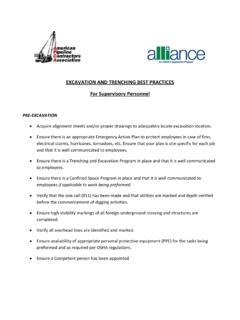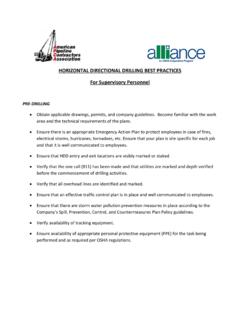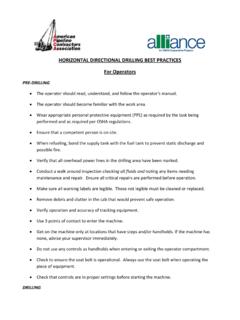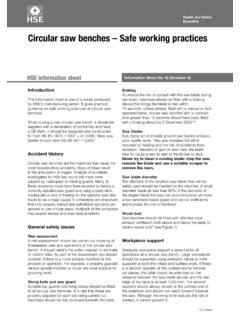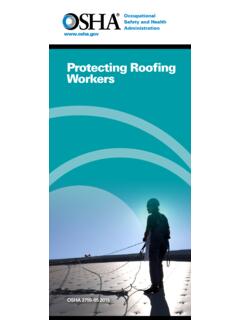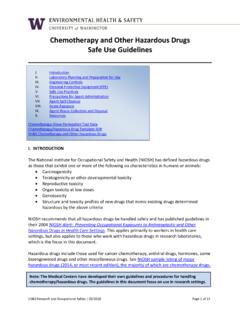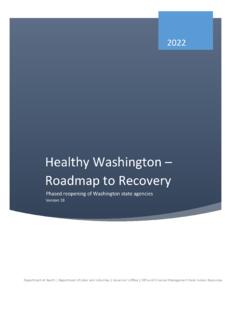Transcription of Best Practices for Transporting & Handling of Pipe
1 best Practices for Transporting & Handling of PipeIntroduction:The Transporting & Handling of pipe consists of 4 main functions: Loading Securement Transporting UnloadingThis document provides safety guidance for each of these functions for drivers and others involved in Transporting and Handling pipe used in the construction of pipelines. Employers are responsible for ensuring that drivers and other workers are properly trained and provided with safe vehicles and other on FMCSA and OSHA Requirements:Federal Motor Carrier Safety Administration (FMCSA) regulations state that a driver must not operate a commercial motor vehicle (CMV) if the load isn t properly secured.
2 The regulations also state that a motor carrier must not allow a driver to transport a load that isn t properly following are some of the key provisions of the (FMCSA) regulations in title 49 of the Code of Federal Regulations: : Requires that drivers know how to properly locate, distribute and secure their cargo. : Requires that drivers not drive the vehicle until the cargo is properly distributed and secured, all vehicle equipment and securement devices are properly secured, and cargo does not interfere with the driver s ability to drive safely.
3 Also requires periodic en route inspections. : Contains the general cargo securement requirements. : Contains the commodity-specific cargo securement the FMCSA s Compliance, Safety, and Accountability (CSA) program, violations for improperly secured cargo are recorded in the CSA scores of both the driver and the that employ truck drivers are also covered under Section 5(a)(1) of the OSH Act of 1970 (OSHA s General Duty Clause) which states that: Each employer shall furnish to each of his employees employment and a place of employment which are free from recognized hazards that are causing or are likely to cause death or serious physical harm to his employees.
4 Specific OSHA regulations may also apply during the loading/unloading OSHA law also includes a whistleblower protection provision that prohibits employers from retaliating (taking adverse action) against employees for exercising their rights under the OSHA law (including the right to raise a health and safety concern or report an injury). Employees that work in the transportation industry are protected from retaliation under other laws for reporting certain violations. For more information, see :Secure the vehicle after arriving at the loading area.
5 No vehicle should ever be left unattended until you are confident it is secure from all equipment and hardware used to load the pipe before may be involved in loading the pipe onto the trailer but sometimes trailers are pre-loaded at the pickup point. Remember that once you sign for the pipe it becomes your responsibility, even if it was damaged or loaded improperly. Improperly loaded pipe or improperly secured pipe can cause damage, injuries, roadside violations and claims against the driver and company. If present as the pipe is being loaded: Avoid parking under or in close proximity to overhead power lines.
6 Park equipment and set brakes, chock wheels and be sure area to load pipe is clear and free of obstructions Keep your personal safety in mind while participating in any part of the loading process and follow all safety requirements and company procedures. Personnel on the ground should stay clear of the loading zone, including all sides of the truck and trailer. Ensure that the area is clear of all personnel except those that are involved in the loading process. Wear proper safety equipment such as hard hats, safety glasses, gloves, safety-toed footwear and reflective vest if appropriate.
7 Before loading begins, review the shipping information to determine the type and weight of pipe you will be hauling. This will enable you to plan for how the weight will be distributed, types and number of tie downs needed, and where those tie downs will be placed. Inspect all pipes before they are loaded to assess their condition. Establish that a spotter is available if needed. Ensure that no damaged pipe is put on the trailer and all piping is listed on the bill of lading. The piping you sign for must be accurately counted and securely and safely loaded on the trailer.
8 Establish that a spotter is available if needed. As pipe is loaded, ensure that the distribution of weight is appropriate and height of the load will not create a center-of-gravity problem. Don t stand under suspended pipe when pipe is being loaded. Nobody should stand on the trailer or back of the truck during the loading of the Pipe:The Federal Motor Carrier Safety Administration (FMCSA) regulations set the minimum standards for to the regulations, each commercial motor vehicle must, when Transporting cargo on public roads, be loaded and equipped in such a manner as to prevent the cargo from: Leaking, spilling, blowing or falling from the motor vehicle.
9 Or Shifting to such an extent that it adversely affects the vehicle s stability or the key concepts of working load limit and aggregate working load limit , determine the minimum number of tiedowns you ll need to secure the Concepts:Proper pipe securement depends on knowing some key concepts from the regulations. Two of these concepts are working load limit and aggregate working load limit which help you comply with the regulations for determining the minimum number of tiedowns load limit:This is the maximum load that may be applied to a component of a cargo securement system (such as tiedowns, binders, ropes, winches, attachment points, etc.)
10 During normal working load limit:The combined restraining capability of a group of securement devices, and the regulations specify a minimum aggregate working load limit to secure a given weight of pipe. Determining the aggregate working load limit depends on how the devices are used to secure the load, using either an indirect or direct tie down aggregate working load limit of the device(s) used to secure an article or group of articles of cargo must equal at least 50% of the weight of the cargo being and placement considerations.
